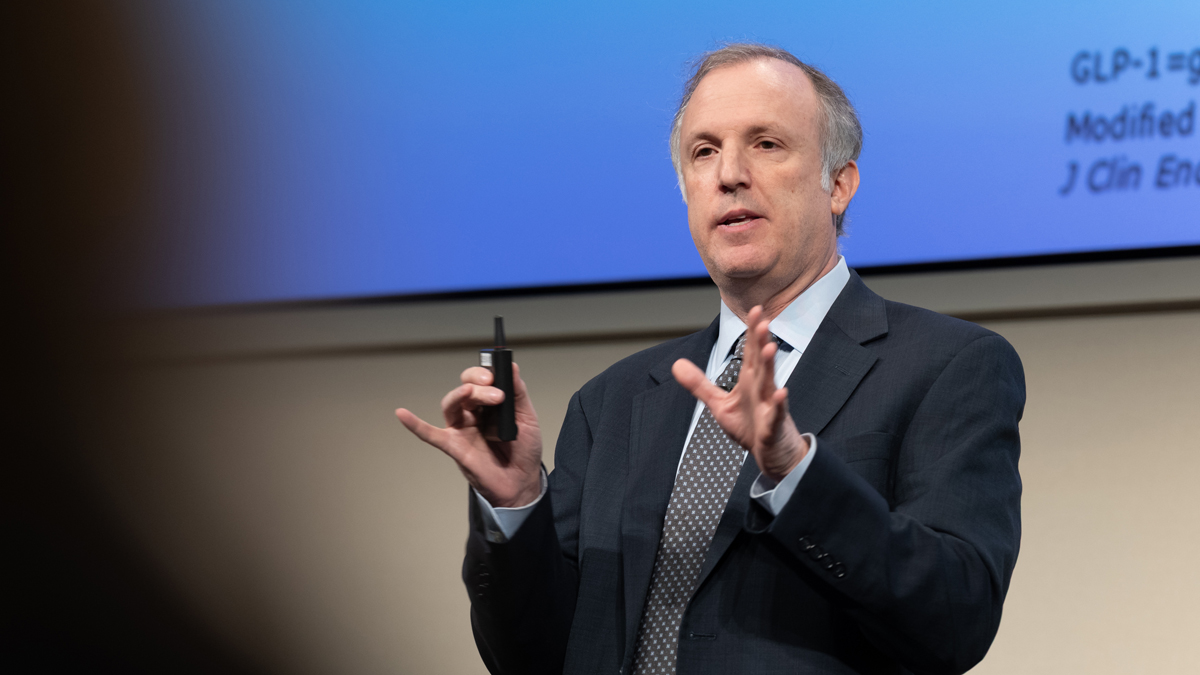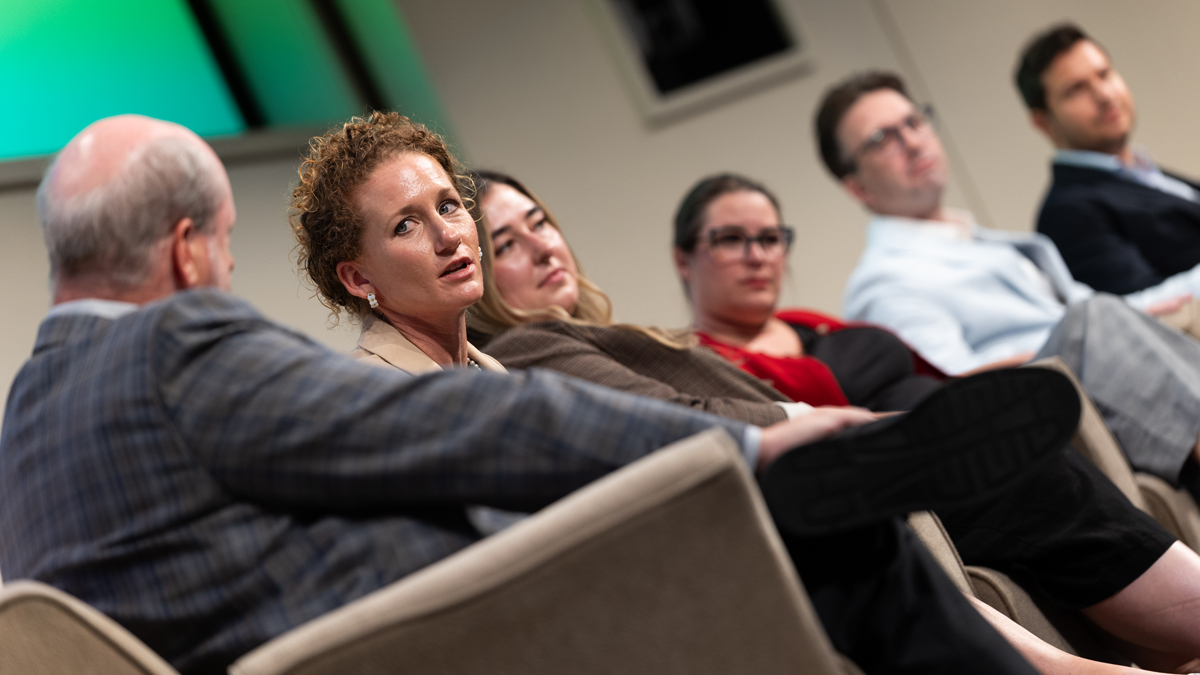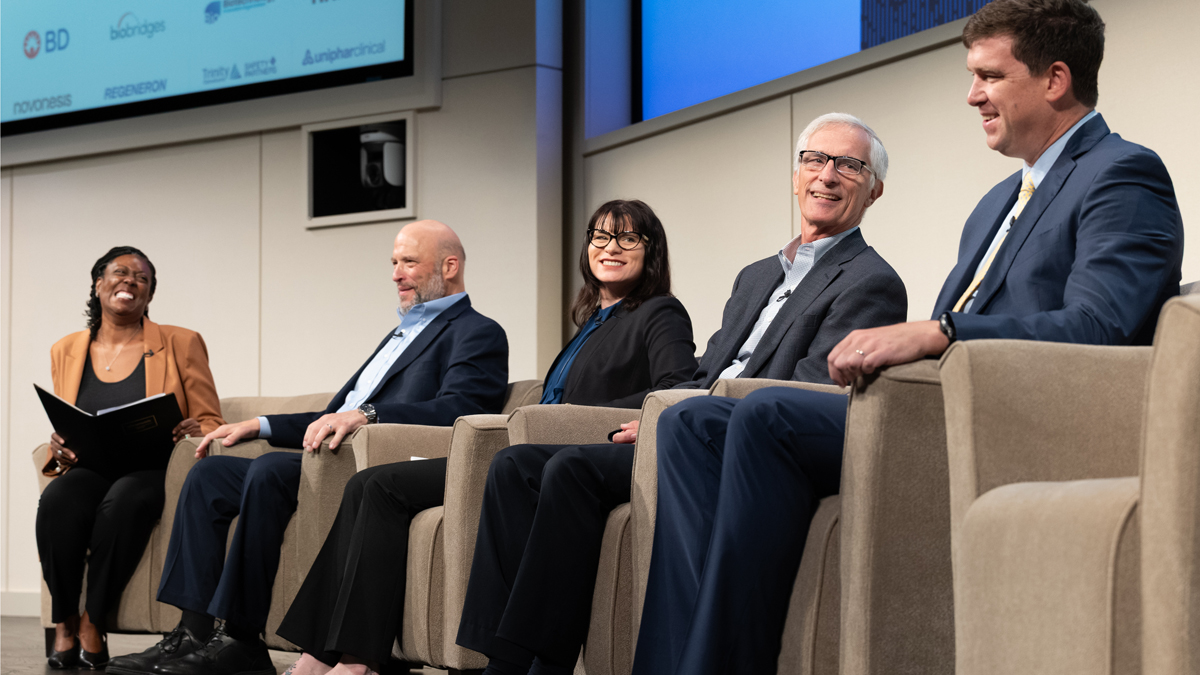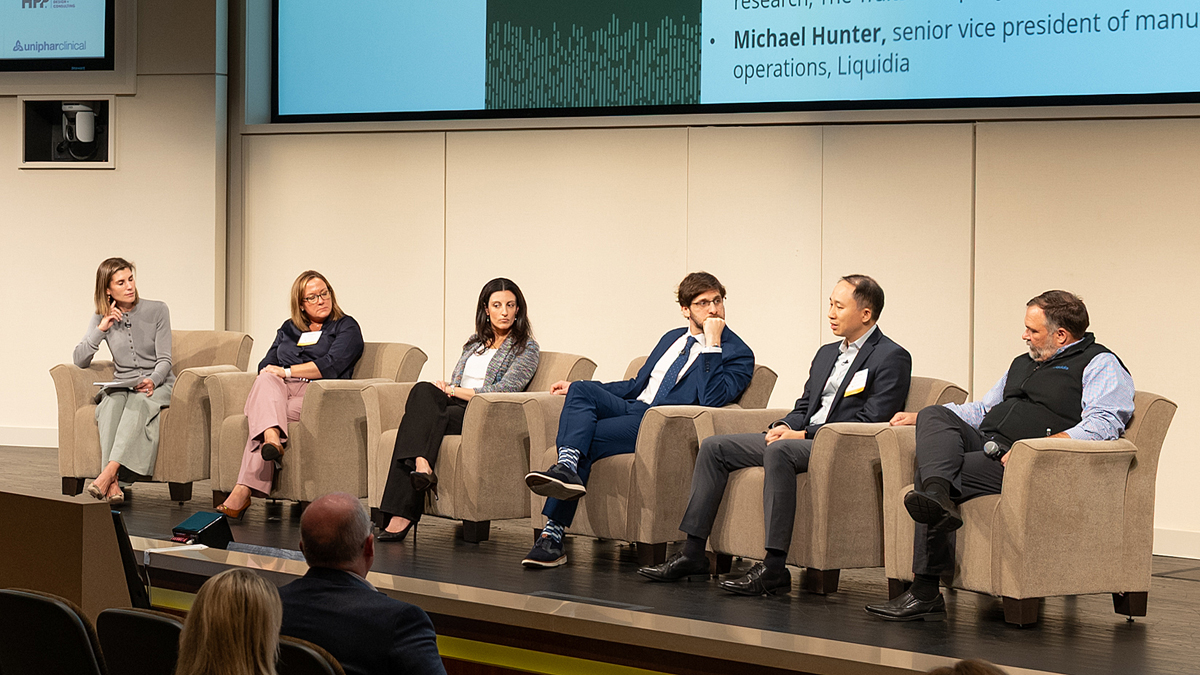2025 NCLifeSci Annual Meeting highlights innovation, challenges
The North Carolina Life Sciences Organization's 2025 Annual Meeting brought together industry leaders, researchers and policymakers Sept. 17 at SAS headquarters in Cary to address pressing challenges facing the state's thriving biotechnology sector.
More than 300 attendees registered to hear discussions covering federal policy, agricultural technology and pharma and groundbreaking technology in North Carolina, underscoring both the opportunities and obstacles confronting the state's life sciences ecosystem.
During the business portion of the meeting, the following individuals were unanimously approved as new members of the NCLifeSci Board of Directors.
- Marcel Frenkel, CEO, Ten63 Therapeutics
- Anil Goyal, CEO, IMMvention Therapeutix
- Courtney Hall, VP, Client Growth & Strategies, BE&K Building Group
- Neil Jones, VP, Corporate Strategic Partnerships, Lindy Biosciences
- Ramin Karimpour, CEO, TARGAN
- Robert Rosenthal, Partner, MED1 Ventures
NCLifeSci President Laura Gunter also recognized the recipients of the 2025-26 Sam Taylor Life Sciences Scholarships:
- Michael Butcher of Montgomery Community College
- Shawn Moore of Central Carolina Community College
- DeAnthonie Taylor of Central Carolina Community College
The Taylor scholarship fund stands at approximately $250,000 and is invested with the NC Community Colleges Foundation.
This year's Annual Meeting was NCLifeSci's largest yet with more than 300 registering to attend. The meeting was made possible by generous sponsorships provided by NCLifeSci members:
Maynard Nexsen was the Podcast Sponsor, and ALT, Avantor, Kymanox and Pfizer were Platinum Sponsors.
The Gold Sponsors for this year's meeting were FUJIFILM Biotechnologies, Grifols, Jazz Pharmaceuticals, Novartis, PSC Biotech and Smith Anderson.
Silver Sponsors were AdvaMed, Alexandria Real Estate Equities, BioCryst Pharmaceuticals, Flad Architects, Frontier Scientific Solutions, Genentech, Kemp Proteins, Eli Lilly and Company, PHCbi Global, SmaBio Labs, UCB and UniFirst Corporation.
Bronze Sponsors were Alira Health, BD, BioBridges, Biotechnology Innovation Organization, HIPP Design + Consulting, Liquidia, Novonesis, Regeneron, Safety Partners and Uniphar Group.
Keynote highlights diabetes breakthrough
To open the meeting, Jason Brett, M.D., principal medical head at Novo Nordisk, delivered the keynote address on the discovery and development of semaglutide, the active ingredient in diabetes medications Ozempic and Wegovy and obesity treatment drugs.
Brett detailed how Novo Nordisk scientists engineered the molecule by modifying the natural hormone GLP-1, which has a half-life of only one to two minutes in the human body regulates blood sugar and appetite.
"Native GLP-1 is not really a viable pharmaceutical candidate, due to its short half-life," Brett explained. "You'd have to give it around the clock."
The breakthrough came through reversible albumin binding using fatty acid acylation, extending the drug's half-life to approximately one week and enabling once-weekly administration.
Brett presented clinical data showing semaglutide's effectiveness not only for diabetes and weight management but also for cardiovascular outcomes and chronic kidney disease. He noted that ongoing trials are investigating the drug's potential in treating Alzheimer's disease, with results expected by the fourth quarter of 2025.
After the keynote, attendees enjoyed three in-depth panel discussions with networking time in between.

Federal update reveals regulatory uncertainty
Moderator Joe Lanier, principal at Milestone Strategies, led a federal policy panel featuring representatives from life sciences advocacy organizations who painted a picture of significant regulatory challenges ahead.
The panelists were:
- Rebecca Haynie, Ph.D., director of science policy and regulatory affairs, CropLife America
- Sophia McLeod, advocacy adviser, ACRO
- Kristin Murphy, vice president of federal government relations, BIO
- Bobby Patrick, senior vice president of government affairs, AdvaMed
- Zach Sentementes, senior director of federal advocacy, PhRMA
The discussion opened with concerns about the Small Business Innovation Research program, which faces a September 30 sunset. Murphy noted that while the House passed a one-year extension, the program remains critical for biotech startups. The panel also addressed administrative challenges in NIH's due diligence processes that have complicated grant evaluations.
Murphy highlighted recent victories, including R&D tax amortization provisions and the Orphan Cures Act in reconciliation legislation.
"These are perfect examples of bills that have broad bipartisan support and have been led by many of our champions here in North Carolina," she said.
The panel discussed the potential for a second reconciliation package, noting that previous provisions rejected by parliamentary rules would need redrafting.
However, the panel expressed concern about reduced federal workforce capacity.
"When we see this reduction in force, particularly in our world with EPA and the office of pesticide programs, you're losing a lot of senior-level institutional knowledge," Haynie noted. "It's now taking around four years to get a new active ingredient pesticide product out of EPA."
She emphasized that agriculture companies advocate for well-funded regulatory agencies to maintain the robust oversight that ensures product safety.
McLeod described the current regulatory environment as "an interesting time" and emphasized the importance of maintaining collaborative relationships with agencies despite personnel changes.
"We've done some really good work over the years building strong relationships, whether that's on AI or things like risk-based quality management."
She noted concerns about whether clinical trials might shift away from the US due to regulatory uncertainty, though data on actual trends remains limited.
Patrick discussed medical device priorities, including Medicare coverage of breakthrough technologies and the industry's focus on zero-for-zero trade agreements to address tariff concerns. The medical device sector, he noted, conducts 90% of its R&D in the US with 70-75% of manufacturing domestically.
Sentementes highlighted ongoing threats to innovation, particularly Most Favored Nation pricing policies and potential tariffs affecting pharmaceutical supply chains.
"Two-thirds of our medicines consumed in the US are made here. That other third primarily comes from Europe. But as soon as we start seeing Europe and Japan not as an ally, but as an opponent, that's where it gets concerning."
The panel addressed pharmacy benefit manager reform as a rare area where progress seemed possible, with increased awareness of PBM practices among lawmakers.

Milestone Strategies' Joe Lanier (left) led a federal policy panel featuring Rebecca Haynie with CropLife America, ACRO's Sophia McLeod, BIO's Kristin Murphy, Advamed's Bobby Patrick and Zach Sentementes with PhRMA
Food and pharma panel explores intersection
Marlene Sanders-Seye, director of state government affairs and policy at Merck, moderated a discussion on the intersection of food, agriculture and pharmaceutical industries.
The panelists were:
- Tom Croce, vice president of global patient advocacy and engagement, Jazz Pharmaceuticals
- Frannie Nilsen, Ph.D., environmental toxicologist, North Carolina Department of Environmental Quality
- Ron Phillips, senior vice president of policy, Animal Health Institute
- Northe Saunders, president, American Families for Vaccines
The conversation centered on combating misinformation and rebuilding public trust in science-based policies. The panel explored how eroding confidence in expertise threatens both food safety and public health initiatives.
The panel addressed growing misinformation challenges affecting public trust in science and medicine.
"The problem that we have is a lack of trust in institutions and a lack of trust in experts," Phillips observed. "I don't know how we fix that entirely."
He noted the emergence of anti-mRNA legislation at state levels, including bills in Utah and Tennessee banning the non-existent practice of using COVID vaccines in livestock to indirectly vaccinate humans through meat consumption.
Nilsen emphasized the importance of public engagement in government processes, noting that DEQ's regulatory meetings and Environmental Management Commission sessions are open to the public. However, she acknowledged that accessing accurate scientific information requires citizens to actively seek out reliable sources rather than relying on social media or politically motivated content.
Croce emphasized the importance of patient engagement in drug development, noting that companies must move beyond traditional approaches.
"No company, including ours, puts the patient at the center of everything we do. Because one, that's impossible. Two, we don't do it. And three, that's incredibly difficult to measure," he said, advocating for earlier patient involvement in the development process.
He described how his company builds feedback loops to inform patients about how their input influences development decisions, even when companies cannot act on all suggestions.
Saunders discussed the challenges facing vaccine advocacy amid political rhetoric.
"There's misinformation coming from the highest levels of government," he said, while noting that polling consistently shows majority support for strong vaccine policies. "The majority of Americans want strong scientific policy. They want strong vaccine policy."
He described how grassroots advocacy chapters have been defending both human and animal health by educating lawmakers about mRNA technology benefits.
Phillips highlighted opportunities in animal health, noting the sector has significantly fewer approved drugs than human medicine despite serving multiple species.
"We have seven major species and a whole host of minor species. We have 1,500 FDA-approved drugs, not over 20,000," he said, contrasting this with human medicine's extensive drug portfolio.
The panel discussed how animal health operates as a cash-pay system without third-party payers, creating different market dynamics than human health care.

Merck's Marlene Sanders-Seye and a panel comprising Jazz Pharmaceuticals' Tom Croce, Frannie Nilsen with NCDEQ, Ron Phillips of the Animal Health Institute and Northe Saunders with American Families for Vaccines discussed issues at the intersection of the food, agriculture and pharmaceutical industries.
Technology landscape showcases NC innovation
Rachel Hardin, head of life sciences business and market development at SAS, moderated the final panel highlighting North Carolina's technology landscape.
The panelists included:
- Juliana Blum, Ph.D., chief executive officer, BioAesthetics
- Laura DiMichele, Ph.D., director of clinical development sciences, BioCryst
- Marcel Frenkel, Ph.D., co-founder and chief executive officer, Ten63 Therapeutics
- Tengfang Huang, Ph.D., vice president and head of research, The Traits Company
- Michael Hunter, senior vice president of manufacturing operations, Liquidia
The discussion explored both the advantages that draw companies to North Carolina and emerging challenges in maintaining competitiveness. Several panelists had relocated from other biotech hubs, providing comparative perspectives on regional strengths and weaknesses.
The panelists discussed factors attracting companies to North Carolina, with several citing the state's combination of quality talent, reasonable costs and strong ecosystem.
"The balance of having quality life, the cost, the ecosystem we have, everything applies to agriculture industry as well," said Huang, whose company works on crop genetics.
Her agricultural biotech company chose North Carolina over other traditional hubs like St. Louis, attracted by both the research environment and quality of life.
Blum described how BioAesthetics moved from San Francisco to Durham in 2018, drawn by lower costs and access to CROs, GMP manufacturing and clinical trial support. The company develops tissue grafts enhanced with drug-delivering polymers for wound-healing applications.
However, remote work trends are changing traditional advantages.
"The pay gap that was one of the things that helped North Carolina is shrinking because now the employee is remote, and they can work from anywhere," Frenkel said. "What we've seen for the really specialized talent, the difference in cost now between that talent in San Francisco and North Carolina is collapsing."
His AI-driven drug discovery company has experienced increased compensation expectations as employees can now command salaries competitive with Bay Area positions while living in North Carolina, he said.
DiMichele described BioCryst's commitment to flexible work arrangements as a key retention strategy.
"We really have embraced that virtual workspace,” she said. “We redesigned our office in 2022 to be this hybrid work environment where people can come in and collaborate but under no requirement to do so."
The company's approach has helped maintain talent across its global operations while respecting employee preferences.
Hunter discussed challenges in scaling manufacturing operations, including increased living costs affecting workforce planning. Liquidia recently signed a lease for 70,000 square feet at Pathway Triangle campus to support commercial manufacturing expansion. The company uses PRINT technology developed at UNC to create precisely controlled drug particles for rare pulmonary diseases.
Funding remains a critical challenge for early-stage companies.
"How do we bring more funding opportunities here to North Carolina? How do we develop more homegrown funding groups here in North Carolina?" asked Blum, whose tissue engineering company moved from San Francisco to Durham in 2018.
She noted that promising companies often get acquired and moved out of state when they reach attractive stages of development.
The panel concluded with calls for amplifying North Carolina's innovation story.
"I think the biggest thing that we could do was let the world know that North Carolina's building the future," Frenkel said. "Making sure that we retain a place where people from different backgrounds and different ideologies and different countries want to come in and build and be successful."
Huang emphasized the importance of building community connections, noting how impressed candidates have been with North Carolina's reputation that they accept offers without site visits.
The meeting highlighted North Carolina's position as a growing life sciences hub while acknowledging persistent challenges in funding, talent retention and regulatory uncertainty that the industry must navigate to maintain its competitive edge.

Rachel Hardin of SAS moderated a final panel highlighting North Carolina's technology landscape. Panelists were Juliana Blum of BioAesthetics, Laura DiMichele, Ph.D. of BioCryst, Marcel Frenkel of Ten63 Therapeutics, Tengfang Huang with The Traits Company and Michael Hunter of Liquidia.
